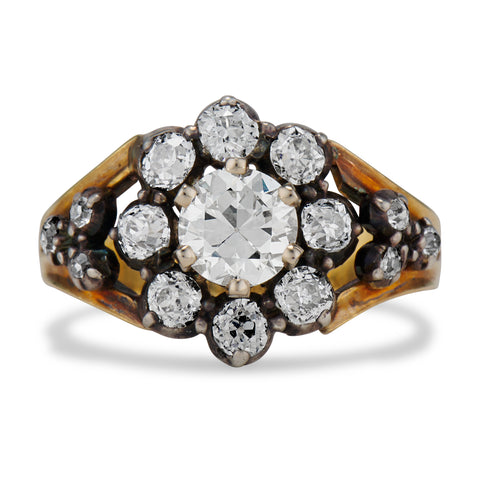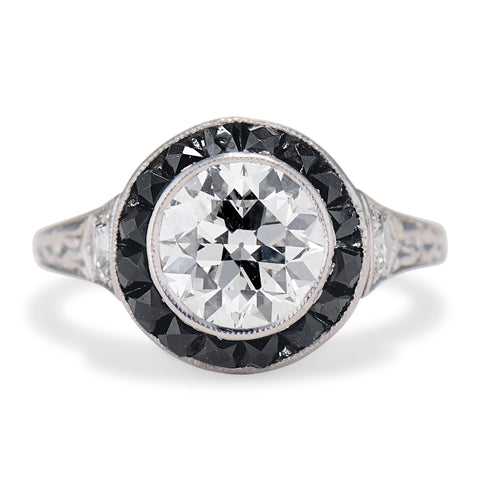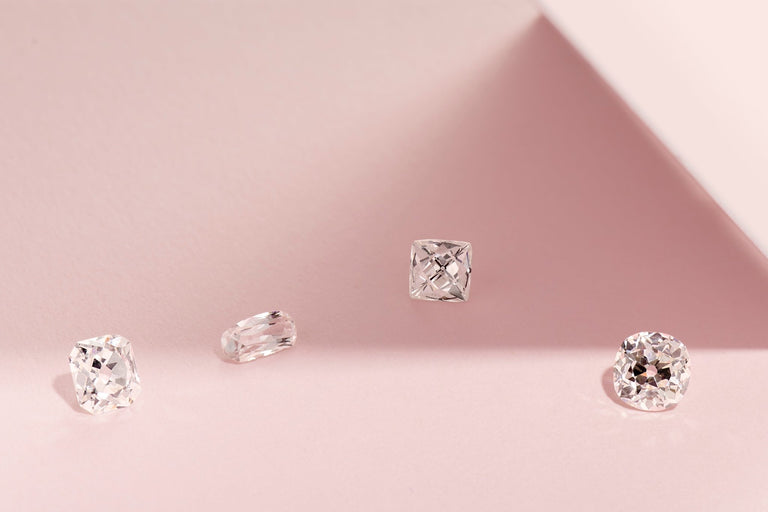An enchanting voyage spanning decades, seamlessly connecting two distinct worlds: the 19th century and the contemporary 20th century, shimmering with brilliance.
The engagement ring has evolved over generations. Some things changed dramatically but some things stayed the same, like the love of diamonds. While diamonds in and of themselves have changed quite a lot. Let's take a journey through time through our collection.
Victorian
Our collection boasts antique rings dating back to the mid-19th century, specifically from the 1850s. This historical period is known as the Victorian era, which encompassed the years from 1837 to 1901.

Jewelry from the earliest part of the Victorian era or from the era predating it, the Georgian period, is very rare. We do occasionally acquire Georgian rings. These pieces are both desirable and expensive due to their age and rarity.

During the Victorian period silver and gold were the most prevalent metals. Platinum has a very high melting point and technology wasn’t developed until the late 19th century to be able to easily work with it in jewelry. Hand engraved warm toned golds were very popular. Authentic antique engraved bands from this time period are coveted to this day.

During the Victorian era, the advent of modern round-ish diamonds marked a significant breakthrough. Among these, the old mine cushion diamond stood out as the precursor to the perfectly round modern brilliant cut. While the old mine cut didn't achieve perfect roundness like its modern counterpart, it represented a departure from previous diamond cuts.
Notably, old mine cut diamonds exhibited distinctive characteristics, including their slightly uneven, bulky shape, an easily discernible culet, and a diminutive table.
However, the initial brilliant cuts were far from symmetrical, showcasing a wide array of facets and outlines that were dependent on the unique qualities of the rough diamonds from which they were crafted.

Natural pearls were prized in the 19th century. Note the pinkish luster of the pearls, patina under the mounting, and heavier more asymmetrical prongs all typical of the era.
As we close the 19th century, jewelry and diamonds begin to take on a more polished and uniform look with more advanced technology.
Edwardian
Let's discuss the concept of overlapping design eras. While there are distinct chronological boundaries, such as the Victorian era concluding in 1901 and giving way to the Edwardian era, which in turn ends in 1910, there exists a certain fluidity in dating antique rings.
When we date a ring as circa 1900, it may straddle the line between the Victorian and Edwardian eras, contingent upon its design aesthetics. Particularly during transitional periods, there was a significant blending of design elements, resulting in overlapping styles and characteristics.

The late Victorian and early Edwardian era heralds an era of resplendent diamonds and unparalleled mastery in jewelry design. While the cluster setting had been favored in previous decades, it undergoes a transformation, adopting a more delicate appearance characterized by finer prongs and the inclusion of brilliant diamonds like the old mine or old European cuts. These exquisite diamonds gained popularity during this period, further enhancing jewelry from this era.

Two-toned engagement rings gained significant popularity during this era, often featuring a platinum mounting paired with a gold band. This choice was not merely a matter of aesthetics but also a practical one. Diamonds from this period tended to possess warmer color tones, and the cool elegance of platinum beautifully complemented the natural warmth of these stones.
The transition to platinum as a primary metal in jewelry began in the early Edwardian era, signaling a shift away from the prevalent use of yellow gold and silver. Platinum, with its exceptionally high melting point, had been somewhat limited in its application in jewelry until the advent of the oxyhydrogen torch in the late 1800s. This innovation unleashed a platinum frenzy that swept across Europe and Russia. By the early 1900s, the fascination with platinum had captivated the American public as well.

During this period, the Old European cut emerged as the favored diamond cut, characterized by its exquisite precision in faceting and symmetry. Meanwhile, Old Mine cut diamonds continued to enjoy popularity, evolving to exhibit enhanced faceting and symmetry, making them even more appealing to connoisseurs of fine jewelry.
Art Nouveau

The Art Nouveau movement, which flourished from 1890 to 1910, left an indelible mark on the world of design. During this era, jewelry drew inspiration from the wonders of the natural world, embracing sinuous, organic lines and intricate botanical motifs.
As technology advanced in the realm of jewelry making, we witnessed the pinnacle of craftsmanship, a zenith that would find its ultimate expression in the forthcoming Art Deco period.
Art Deco
Undoubtedly, one of the most beloved vintage eras, the Art Deco period graced us from 1920 to 1935. It's worth noting that only rings adorned with distinctive Art Deco design motifs are officially classified as Art Deco. Nevertheless, whether it's recognized as Art Deco or simply hails from the glamorous 1920s, the jewelry from this era exudes sheer magnificence.
Engagement rings from this period are characterized by their sleek, modern lines. Solitaires take center stage, available in a delightful array of prong and mounting styles, each one a testament to the enduring allure of this era's design sensibilities.
The target setting is one of the most recognizable Deco styles of the period.

Simultaneously, diamond cutting evolved, allowing for the precision of perfectly round shapes and cuts that radiated unparalleled brilliance. The old European diamond, with its timeless shape, took center stage in the world of gemstones. This captivating beauty served as an inspiration, paving the way for the transition cut and ultimately the modern round brilliant diamond.
While the old European cut, affectionately referred to as the "old Euro," had been in existence for several decades, it wasn't until the early 20th century that it became ubiquitous, coinciding with the rise of new technology. These diamonds, hand-faceted without standardized parameters, are truly one-of-a-kind. Their substantial, round brilliance finds a perfect complement in crisp platinum settings, rendering them exceedingly desirable in the contemporary jewelry landscape.

Another fabulous cut to make itself known during the early 20th century was the innovative and brand new Asscher diamond. The Asscher cut was created in 1902 by Joseph Isaac Asscher and was the first diamond cut to be patented. The cut is similar to an emerald cut in the square shape but with cropped corners and modified faceting which creates a more brilliant look.
The Asscher cut was extremely popular, particularly in Art Deco jewelry designs. It reached its peak popularity in the 1920s, which is one of the reasons many modern brides see Asscher-cut diamonds as “antique” or “vintage.”

The hallmark of Art Deco style lies in its elegant simplicity and clean lines. Often crafted from opulent materials such as platinum, diamonds, emeralds, and sapphires, these precious stones find their place within geometric or stylized settings. While Art Deco creations were not typically mass-produced, they drew inspiration from the modernity of machinery and the inherent design qualities of machine-made objects, embracing attributes like simplicity, symmetry, and repeated elements.
As we transition into the 1930s, the Deco design movement continues to flourish. Jewelry takes substantial influence from the sleek skyscrapers of the era, most notably the iconic Chrysler Building in New York. During this period, jewelry exhibits a sense of weightiness, featuring robust settings and solid prongs.
Diamonds, too, undergo a transformation, adopting fresh proportions such as the marquise cut diamond. While the old European cut remains a favorite for engagement rings, the transition cut begins to emerge as well. These cuts, also known as early modern cuts, serve as precursors to the modern round brilliant cut, among the first diamonds to boast standardized proportions.
Mid Century

By the 1940s, we observe a shift from the high design sensibilities of Art Deco to the emergence of Mid Century Modern aesthetics, which spanned roughly from 1950 to 1965, or some argue even earlier. Mid Century engagement rings embrace minimal ornamentation, favoring uncluttered, ultra-clean lines that echo the streamlined principles of the Deco movement, distilled to their simplest forms. During this era, the ideology of "form follows function" reigns supreme.






